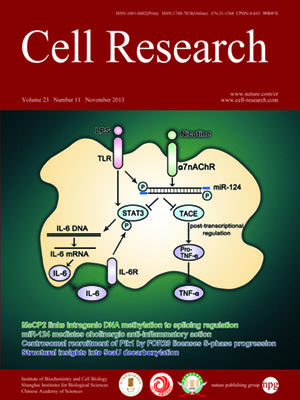
Volume 23, No 11, Nov 2013
ISSN: 1001-0602
EISSN: 1748-7838 2018
impact factor 17.848*
(Clarivate Analytics, 2019)
Volume 23 Issue 11, November 2013: 1270-1283 | Open Access
ORIGINAL ARTICLES
MicroRNA-124 mediates the cholinergic anti-inflammatory action through inhibiting the production of pro-inflammatory cytokines
Yang Sun1,*, Qi Li1,*, Huan Gui1, Dong-Ping Xu1, Yi-Li Yang2, Ding-Feng Su1 and Xia Liu1
1Department of Pharmacology, School of Pharmacy, Second Military Medical University, Shanghai 200433, China
2Cancer and Developmental Biology Laboratory, National Cancer Institute, National Institutes of Health, Frederick, MD 21702, USA
Correspondence: Xia Liu, Tel: (+86)-21-81871270; Fax: (+86)-21-65493951 E-mail: lxflying@aliyun.com; Ding-Feng Su, E-mail: dfsu2008@gmail.com; Yi-Li Yang(yiliyang@mail.nih.gov)
The vagus nerve can control inflammatory response through a 'cholinergic anti-inflammatory pathway', which is mediated by the α7-nicotinic acetylcholine receptor (α7nAChR) on macrophages. However, the intracellular mechanisms that link α7nAChR activation and pro-inflammatory cytokine production remain not well understood. In this study, we found that miR-124 is upregulated by cholinergic agonists in LPS-exposed cells and mice. Utilizing miR-124 mimic and siRNA knockdown, we demonstrated that miR-124 is a critical mediator for the cholinergic anti-inflammatory action. Furthermore, our data indicated that miR-124 modulates LPS-induced cytokine production by targeting signal transducer and activator of transcription 3 (STAT3) to decrease IL-6 production and TNF-α converting enzyme (TACE) to reduce TNF-α release. These results also indicate that miR-124 is a potential therapeutic target for the treatment of inflammatory diseases.
10.1038/cr.2013.116
FULL TEXT | PDF
Browse 2853


